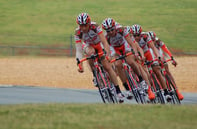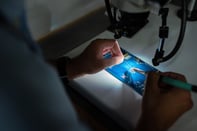Published on
Engineering Education for a Skills-First World

Engineering education is evolving to meet shifting workforce demands. Institutions are embracing stackable credentials and emerging tech like AR and AI to deliver flexible, skill-based learning that’s accessible, scalable and aligned with real-world needs. In this interview, Sunay Palsole discusses the shift toward stackable credentials and the role emerging technology plays.
The EvoLLLution (Evo): How has engineering education evolved in response to changing workforce demands?
Sunay Palsole (SP): The big shift has been realizing we must be more responsive to market needs. Traditional degree updates take years to approve, by which time industry needs have changed. To move faster, we’ve embraced stackable credentials—short courses, certificates and microcredentials that build toward degrees.
For example, as AI advances rapidly, we launched practical AI courses—offered for credit or noncredit—to quickly upskill learners. These stack into certificates, which stack into degrees, ensuring students gain immediately useful skills while staying on track for larger academic goals.
The second major change is expanding online learning. Engineering education can’t be limited to on-campus instruction anymore. While remote labs remain a challenge, schools are embracing more creative online approaches to keep up with evolving industry demands.
Evo: What are the biggest challenges to adapting a more traditional engineering curriculum to a more flexible competency-based learning model?
SP: One of the biggest challenges is helping faculty rethink learning models. They’re not resisting change. They’re curriculum experts who want to ensure breaking content into smaller, flexible chunks still leads to deep understanding. Many worry modularizing courses could dilute learning, but the key is designing effective assessments that measure competency, not just academic performance. Engineering education isn’t about making better students but making better engineers.
Technology and infrastructure also pose hurdles. Competency-based models let students progress at their own pace, but traditional systems struggle to track and report this progression efficiently. Institutions built for CBE adapt more easily, but retrofitting larger campuses is a challenge.
Finally, defining and measuring true mastery in engineering is complex. It’s not just about passing exams but proving real-world skills. Moving beyond rigid timelines to dynamic, skills-based evaluations requires a strategic, long-term commitment to keep engineering education aligned with industry needs.
Evo: What role does remote and hybrid learning play in making engineering education more accessible and workforce relevant?
SP: Remote and hybrid learning play a massive role in making engineering education more accessible and workforce relevant. In many cases, they are the key drivers of workforce engagement. If someone in Saskatchewan wants to learn from the University of Toronto or an industry in El Paso, Texas, needs upskilling opportunities from Texas A&M, travel is cumbersome and often isn’t an option. Remote learning bridges that gap and allows education to be delivered where and when learners need it.
Beyond access, online learning enhances engagement in ways traditional classrooms can’t. Faculty do a great job of ensuring students stay engaged, but online platforms offer real-time data on how students interact with content and their struggles, if any, allowing for immediate adjustments. Remote learning also enables collaborative problem solving—if a student struggles, the system can suggest peer connections on the fly, something far more difficult in a live classroom.
For workforce training, remote learning is essential. Companies adopting new technology can’t always send employees back to campus, but online programs let them train on site, using the actual equipment they’ll work with. This approach takes education to a whole new level, making it more practical, flexible and immediately applicable.
Evo: How can institutions integrate hands-on experiential learning into remote engineering programs without compromising quality?
SP: Hands-on learning is one of the biggest challenges in remote engineering education, which is why adoption has been slow. Most online engineering courses focus on programming and design labs, where students can use remote software and simulators. But for more physical, hands-on lab work, it’s far trickier.
The real game changer is AR, VR, IoT devices and digital twinning. As costs drop, these tools can create highly immersive, interactive lab experiences. For example, some universities have developed digital twin partnerships with industry, allowing students to interact with real-world systems remotely. We built an AR-powered nuclear reactor simulation to help students understand power generation, and a welding training module using AR goggles. It’s not the same as on-site welding, but it provides realistic, hands-on practice without the risks.
IoT also plays a role. Students can remotely control machines like CNC routers, gaining real-world skills without needing to be physically present. While development time for these tools is still high, the potential for scalable, high-quality experiential learning is enormous.
Evo: What innovations in remote engineering education will have the greatest impact on preparing graduates for the future of work?
SP: One of the biggest innovations needed in remote engineering education or education generally is not necessarily in technology but in accreditation and policy. The current system ensures students get what they pay for, but it’s also rigid and slow, making it difficult to adapt to industry changes. Take journalism: 30 years ago, students trained for print and film media, but social media and podcasts now dominate. Schools should be able to quickly offer microcredentials and academic degrees to help professionals upskill as industries evolve.
Engineering faces the same challenge. Some fundamentals stay the same, but the field is constantly shifting. However, modifying a curriculum by more than 50% triggers a long approval process, slowing progress. Instead, we need agile, adaptable programs that allow for continuous learning.
AI and digital twinning will also play a major role. If AI could assess students’ prior learning and map out personalized competency pathways, it would streamline upskilling and reduce barriers. The ability to integrate AI into curriculum design and learning itself could be one of the most transformative innovations for engineering education.
Evo: Is there anything you’d like to add?
SP: The future of engineering education will rely heavily on industry partnerships. To stay workforce relevant, institutions and policymakers must embrace rapid curriculum changes. What used to take six months or two years needs to shrink to weeks or months. Faculty will recognize the value of a more adaptive approach, but it requires rethinking traditional processes.
Workforce education isn’t just about industry, it’s education itself. The key shift ahead is stackable microcredentials and short credentials, making lifelong learning more accessible. However, many industry partners still don’t fully understand microcredentials or even shorter academic credentials such as certificates, so bridging that gap will be crucial for future success.



